

***Description for this perennial available with future update!***Variegated Fallopia, is also known as Fallopia japonica 'Variegata'
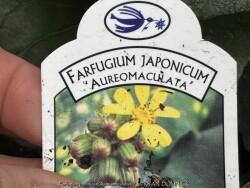

***Description for this plant available with future update!*** Farfugium japonicum 'Aureomaculatum' is also known as Yellow Variegated Leopard Plant / Tractor Seat Plant.


***Description for this plant available with future update!*** Farfugium japonicum 'Gigantea' is also known as Giant Leopard Plant / Tractor Seat Plant.
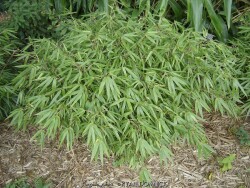

Dragon Head Bamboo (Fargesia rufa) is a wonderful relatively new bamboo introduction with bright green leaves, red sheaths on new canes, and most importantly, a CLUMPING growth habit. This plant creates a soft textured tropical lush appearance in the garden. This unique and interesting plant is evergreen to -5 degree F and grows to about 2-3 feet in Eastern Kansas. (the published 6-10 feet is only achieved in desirable more stable climates like Oregon) Fargesia rufa provides shelter for birds, is not troubled by any diseases, insects, or animals, and is resistant to drought and heat after established. In Eastern Kansas, typically our 40 inches of rainfall is sufficient without extra water if planted in good soils. It is best grown in organically rich, acidic, well-drained soils in part shade but tolerates full shade (not dry-shade). It prefers cool summer climates; although we are on the Southern edge of this plants adaptability, it still survives reasonably well here. Look for a cold microclimate planting location such as East or North exposure. It needs some morning sun but lots of protection from hot afternoon sun. Does not perform well in the hot and humid summers of the southeastern U.S. or anywhere south of zone 6b. I have witnesses plants die in zone 7a from summer heat exhaustion. Mulch in winter will provide protection for the roots and expect occasional die-back when temperatures hit -5 to -10 degrees F. Repeated or successive cold winters with complete foliage loss seem to be an issue with this and many evergreen zone 6/7 plants. One occasional difficult winter followed by mild winters is more tolerable. This plant, however, will generally recover in one summer with decent watering and fertilizer. Plants do not "run" in the landscape like traditional bamboo and are not invasive; think of it as an evergreen ornamental grass with a nice compact fountain-like appearance.
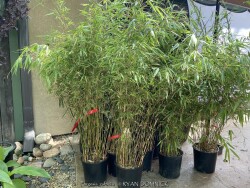

Dragon Head Bamboo (Fargesia rufa) is a wonderful relatively new bamboo introduction with bright green leaves, red sheaths on new canes, and most importantly, a CLUMPING growth habit. This plant creates a soft textured tropical lush appearance in the garden. This unique and interesting plant is evergreen to -5 degree F and grows to about 2-3 feet in Eastern Kansas. (the published 6-10 feet is only achieved in desirable more stable climates like Oregon) Fargesia rufa provides shelter for birds, is not troubled by any diseases, insects, or animals, and is resistant to drought and heat after established. In Eastern Kansas, typically our 40 inches of rainfall is sufficient without extra water if planted in good soils. It is best grown in organically rich, acidic, well-drained soils in part shade but tolerates full shade (not dry-shade). It prefers cool summer climates; although we are on the Southern edge of this plants adaptability, it still survives reasonably well here. Look for a cold microclimate planting location such as East or North exposure. It needs some morning sun but lots of protection from hot afternoon sun. Does not perform well in the hot and humid summers of the southeastern U.S. or anywhere south of zone 6b. I have witnesses plants die in zone 7a from summer heat exhaustion. Mulch in winter will provide protection for the roots and expect occasional die-back when temperatures hit -5 to -10 degrees F. Repeated or successive cold winters with complete foliage loss seem to be an issue with this and many evergreen zone 6/7 plants. One occasional difficult winter followed by mild winters is more tolerable. This plant, however, will generally recover in one summer with decent watering and fertilizer. Plants do not "run" in the landscape like traditional bamboo and are not invasive; think of it as an evergreen ornamental grass with a nice compact fountain-like appearance.
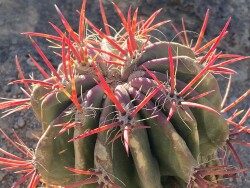

Fire Barrel Cacti (Ferocactus sp.) are known for their bright red spines. Native to the Mojave desert south to the desert of Baja California, it's usually grown as a patio or house plant in Kansas. In the wild, some fire barrel species are hardy to 20 degrees F. Grow in full sun with no extra watering except that which comes from rainfall. Repotting may or may not be needed depending on how large you want the plant to grow; plants can continue to grow taller and tolerate extremely root-bound pots but may need wind bracing. If repotting, make sure to use a sharp draining low organic cactus mix with plenty of sand and perlite. Potted plants are hardy to at least 25 degrees F for a short time if kept dry so you are ok if you miss the first light frost. Do not allow the pot with rootball to freeze solid though. Before extreme cold occurs, move to a bright interior window over the winter with no watering and keep above freezing. As a winter house plant, it will look presentable all winter long with just no waterings.(also to prevent lanky winter growth) As a permanent house plant, provide bright light and allow the soil to dry between waterings for many years of carefree enjoyment. Plants grown permanently indoors may begin to elongate stretching for light and lose their spine color. It can be hard to reproduce the intense UV sunlight they need so moving outside for the summer is best. Generally if moving outside for the summer, allow 1-2 weeks of part shade or morning sun before placing in full sun. Plants with time to acclimate will thrive in full sun but be careful not to rush it or sunburning will occur. Potted plants are very low maintenance but watch for scale and mealybugs that may hide beneath the cover of spines.
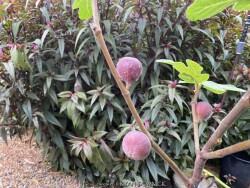

The common fig (Ficus carica) is native to an area extending from Asiatic Turkey to northern India. In Kansas, plant in a protected area near the house on south or west side but will survive in other locations in full hot sun. As an edible, ornamental plant, figs are an attractive bush-like plant with sandpapery green sometimes deeply lobed leaves. There is a slight and pleasant aroma when brushing against the foliage. Fruits are dark purple to maroon. Figs love full hot sun and are very drought tolerant but will produce more fruit if watered during the summer. Expect fig tree to die to the ground each year and start growing in May a bit later than other plants. Regrowth is rapid and established figs will have dozens of 5-6' water sprouts loaded with a few hundred fruits by September. You will always get a late summer/fall crop because fruit can come from new wood. If growing as a potted patio plant, grow in full sun with plenty of water during the summer. Then in late fall before temperatures get below 20 degrees F, move into a cold garage or basement over the winter with minimal watering. Do not allow the pot with rootball to freeze solid or go below 15 degrees for more than a few hours. By March or April, the fig will be trying to grow and you may put back outside (protect from late frosts) and you will also have a spring fruit crop. Eat fresh, freeze for fruit smoothies, or dry in sun or food dehydrator. In our trial gardens in Lawrence, KS (zone 6a), several established specimens planted 5-10 years ago and mulched 1-3" with wood mulch survived -17 degrees F. During the arctic blast of February, 2021, lows down to -17 degrees F on Feb 16th, 2021 were recorded. The longevity of this cold blast was also impressive: 10 days on a row with highs of 10-15 degrees F or lower, 8 nights of lows in the single digits and negatives, and 36 straight hours of 0 degrees F and mostly lower. 'Chicago Hardy' is considered to be one of the hardiest edible figs producing reliable fruits. It's stems are hardy to 10°F and the roots are hardy to -20°F. Sometimes if prolonged September cold-fronts occur and temperatures are too low at night, green fruits will disappointingly stop ripening. Look for a hot planting location microclimate such as a West or South wall to encourage fruit to ripen. Ripening does not continue to progress if harvested early (when fruit has any green coloring present).
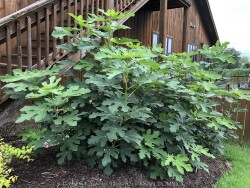

The common fig (Ficus carica) is native to an area extending from Asiatic Turkey to northern India. In Kansas, plant in a protected area near the house on south or west side but will survive in other locations in full hot sun. As an edible, ornamental plant, figs are an attractive bush-like plant with sandpapery green sometimes deeply lobed leaves. There is a slight and pleasant aroma when brushing against the foliage. Fruits are dark purple to maroon. Figs love full hot sun and are very drought tolerant but will produce more fruit if watered during the summer. Expect fig tree to die to the ground each year and start growing in May a bit later than other plants. Regrowth is rapid and established figs will have dozens of 5-6' water sprouts loaded with a few hundred fruits by September. You will always get a late summer/fall crop because fruit can come from new wood. If growing as a potted patio plant, grow in full sun with plenty of water during the summer. Then in late fall before temperatures get below 20 degrees F, move into a cold garage or basement over the winter with minimal watering. Do not allow the pot with rootball to freeze solid or go below 15 degrees for more than a few hours. By March or April, the fig will be trying to grow and you may put back outside (protect from late frosts) and you will also have a spring fruit crop. Eat fresh, freeze for fruit smoothies, or dry in sun or food dehydrator. In our trial gardens in Lawrence, KS (zone 6a), several established specimens planted 5-10 years ago and mulched 1-3" with wood mulch survived -17 degrees F. During the arctic blast of February, 2021, lows down to -17 degrees F on Feb 16th, 2021 were recorded. The longevity of this cold blast was also impressive: 10 days on a row with highs of 10-15 degrees F or lower, 8 nights of lows in the single digits and negatives, and 36 straight hours of 0 degrees F and mostly lower. 'Chicago Hardy' is considered to be one of the hardiest edible figs producing reliable fruits. It's stems are hardy to 10°F and the roots are hardy to -20°F. Sometimes if prolonged September cold-fronts occur and temperatures are too low at night, green fruits will disappointingly stop ripening. Look for a hot planting location microclimate such as a West or South wall to encourage fruit to ripen. Ripening does not continue to progress if harvested early (when fruit has any green coloring present).
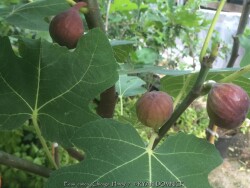

The common fig (Ficus carica) is native to an area extending from Asiatic Turkey to northern India. In Kansas, plant in a protected area near the house on south or west side but will survive in other locations in full hot sun. As an edible, ornamental plant, figs are an attractive bush-like plant with sandpapery green sometimes deeply lobed leaves. There is a slight and pleasant aroma when brushing against the foliage. Fruits are dark purple to maroon. Figs love full hot sun and are very drought tolerant but will produce more fruit if watered during the summer. Expect fig tree to die to the ground each year and start growing in May a bit later than other plants. Regrowth is rapid and established figs will have dozens of 5-6' water sprouts loaded with a few hundred fruits by September. You will always get a late summer/fall crop because fruit can come from new wood. If growing as a potted patio plant, grow in full sun with plenty of water during the summer. Then in late fall before temperatures get below 20 degrees F, move into a cold garage or basement over the winter with minimal watering. Do not allow the pot with rootball to freeze solid or go below 15 degrees for more than a few hours. By March or April, the fig will be trying to grow and you may put back outside (protect from late frosts) and you will also have a spring fruit crop. Eat fresh, freeze for fruit smoothies, or dry in sun or food dehydrator. In our trial gardens in Lawrence, KS (zone 6a), several established specimens planted 5-10 years ago and mulched 1-3" with wood mulch survived -17 degrees F. During the arctic blast of February, 2021, lows down to -17 degrees F on Feb 16th, 2021 were recorded. The longevity of this cold blast was also impressive: 10 days on a row with highs of 10-15 degrees F or lower, 8 nights of lows in the single digits and negatives, and 36 straight hours of 0 degrees F and mostly lower. 'Chicago Hardy' is considered to be one of the hardiest edible figs producing reliable fruits. It's stems are hardy to 10°F and the roots are hardy to -20°F. Sometimes if prolonged September cold-fronts occur and temperatures are too low at night, green fruits will disappointingly stop ripening. Look for a hot planting location microclimate such as a West or South wall to encourage fruit to ripen. Ripening does not continue to progress if harvested early (when fruit has any green coloring present).
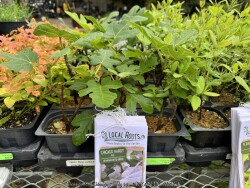

The common fig (Ficus carica) is native to an area extending from Asiatic Turkey to northern India. In Kansas, plant in a protected area near the house on south or west side but will survive in other locations in full hot sun. As an edible, ornamental plant, figs are an attractive bush-like plant with sandpapery green sometimes deeply lobed leaves. There is a slight and pleasant aroma when brushing against the foliage. Fruits are dark purple to maroon. Figs love full hot sun and are very drought tolerant but will produce more fruit if watered during the summer. Expect fig tree to die to the ground each year and start growing in May a bit later than other plants. Regrowth is rapid and established figs will have dozens of 5-6' water sprouts loaded with a few hundred fruits by September. You will always get a late summer/fall crop because fruit can come from new wood. If growing as a potted patio plant, grow in full sun with plenty of water during the summer. Then in late fall before temperatures get below 20 degrees F, move into a cold garage or basement over the winter with minimal watering. Do not allow the pot with rootball to freeze solid or go below 15 degrees for more than a few hours. By March or April, the fig will be trying to grow and you may put back outside (protect from late frosts) and you will also have a spring fruit crop. Eat fresh, freeze for fruit smoothies, or dry in sun or food dehydrator. In our trial gardens in Lawrence, KS (zone 6a), several established specimens planted 5-10 years ago and mulched 1-3" with wood mulch survived -17 degrees F. During the arctic blast of February, 2021, lows down to -17 degrees F on Feb 16th, 2021 were recorded. The longevity of this cold blast was also impressive: 10 days on a row with highs of 10-15 degrees F or lower, 8 nights of lows in the single digits and negatives, and 36 straight hours of 0 degrees F and mostly lower. 'Chicago Hardy' is considered to be one of the hardiest edible figs producing reliable fruits. It's stems are hardy to 10°F and the roots are hardy to -20°F. Sometimes if prolonged September cold-fronts occur and temperatures are too low at night, green fruits will disappointingly stop ripening. Look for a hot planting location microclimate such as a West or South wall to encourage fruit to ripen. Ripening does not continue to progress if harvested early (when fruit has any green coloring present).
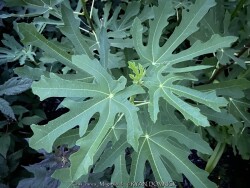

The common fig (Ficus carica) is native to an area extending from Asiatic Turkey to northern India. In Kansas, plant in a protected area near the house on south or west side but will survive in other locations in full hot sun. As an edible, ornamental plant, figs are an attractive bush-like plant with sandpapery green sometimes deeply lobed leaves. There is a slight and pleasant aroma when brushing against the foliage. Fruits are dark purple to maroon. Figs love full hot sun and are very drought tolerant but will produce more fruit if watered during the summer. Expect fig tree to die to the ground each year and start growing in May a bit later than other plants. Regrowth is rapid and established figs will have dozens of 5-6' water sprouts loaded with a few hundred fruits by September. You will always get a late summer/fall crop because fruit can come from new wood. If growing as a potted patio plant, grow in full sun with plenty of water during the summer. Then in late fall before temperatures get below 20 degrees F, move into a cold garage or basement over the winter with minimal watering. Do not allow the pot with rootball to freeze solid or go below 15 degrees for more than a few hours. By March or April, the fig will be trying to grow and you may put back outside (protect from late frosts) and you will also have a spring fruit crop. Eat fresh, freeze for fruit smoothies, or dry in sun or food dehydrator. In our trial gardens in Lawrence, KS (zone 6a), three specimens planted in 2020 and mulched 1-3" with wood mulch. Surprisingly, they survived -17 degrees F. During that arctic blast of February, 2021, lows down to -17 degrees F on Feb 16th, 2021 were recorded. The longevity of this cold blast was also impressive: 10 days on a row with highs of 10-15 degrees F or lower, 8 nights of lows in the single digits and negatives, and 36 straight hours of 0 degrees F and mostly lower. Magnolia Large Fruiting Fig (Ficus carica 'Magnolia') has slightly larger more deeply lobed foliage that is more ornamental. The fruit is large with brown skin and amber pulp. Pick the fruit just before maturity for a perfect flavor and to avoid souring and splitting. Sometimes if prolonged September cold-fronts occur and temperatures are too low at night, green fruits will disappointingly stop ripening. Look for a hot planting location microclimate such as a West or South wall to encourage fruit to ripen. Ripening does not continue to progress if harvested early (when fruit has any green coloring present).
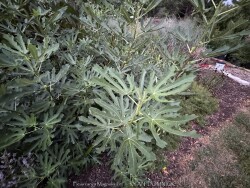

The common fig (Ficus carica) is native to an area extending from Asiatic Turkey to northern India. In Kansas, plant in a protected area near the house on south or west side but will survive in other locations in full hot sun. As an edible, ornamental plant, figs are an attractive bush-like plant with sandpapery green sometimes deeply lobed leaves. There is a slight and pleasant aroma when brushing against the foliage. Fruits are dark purple to maroon. Figs love full hot sun and are very drought tolerant but will produce more fruit if watered during the summer. Expect fig tree to die to the ground each year and start growing in May a bit later than other plants. Regrowth is rapid and established figs will have dozens of 5-6' water sprouts loaded with a few hundred fruits by September. You will always get a late summer/fall crop because fruit can come from new wood. If growing as a potted patio plant, grow in full sun with plenty of water during the summer. Then in late fall before temperatures get below 20 degrees F, move into a cold garage or basement over the winter with minimal watering. Do not allow the pot with rootball to freeze solid or go below 15 degrees for more than a few hours. By March or April, the fig will be trying to grow and you may put back outside (protect from late frosts) and you will also have a spring fruit crop. Eat fresh, freeze for fruit smoothies, or dry in sun or food dehydrator. In our trial gardens in Lawrence, KS (zone 6a), three specimens planted in 2020 and mulched 1-3" with wood mulch. Surprisingly, they survived -17 degrees F. During that arctic blast of February, 2021, lows down to -17 degrees F on Feb 16th, 2021 were recorded. The longevity of this cold blast was also impressive: 10 days on a row with highs of 10-15 degrees F or lower, 8 nights of lows in the single digits and negatives, and 36 straight hours of 0 degrees F and mostly lower. Magnolia Large Fruiting Fig (Ficus carica 'Magnolia') has slightly larger more deeply lobed foliage that is more ornamental. The fruit is large with brown skin and amber pulp. Pick the fruit just before maturity for a perfect flavor and to avoid souring and splitting. Sometimes if prolonged September cold-fronts occur and temperatures are too low at night, green fruits will disappointingly stop ripening. Look for a hot planting location microclimate such as a West or South wall to encourage fruit to ripen. Ripening does not continue to progress if harvested early (when fruit has any green coloring present).
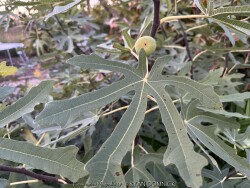

The common fig (Ficus carica) is native to an area extending from Asiatic Turkey to northern India. In Kansas, plant in a protected area near the house on south or west side but will survive in other locations in full hot sun. As an edible, ornamental plant, figs are an attractive bush-like plant with sandpapery green sometimes deeply lobed leaves. There is a slight and pleasant aroma when brushing against the foliage. Fruits are dark purple to maroon. Figs love full hot sun and are very drought tolerant but will produce more fruit if watered during the summer. Expect fig tree to die to the ground each year and start growing in May a bit later than other plants. Regrowth is rapid and established figs will have dozens of 5-6' water sprouts loaded with a few hundred fruits by September. You will always get a late summer/fall crop because fruit can come from new wood. If growing as a potted patio plant, grow in full sun with plenty of water during the summer. Then in late fall before temperatures get below 20 degrees F, move into a cold garage or basement over the winter with minimal watering. Do not allow the pot with rootball to freeze solid or go below 15 degrees for more than a few hours. By March or April, the fig will be trying to grow and you may put back outside (protect from late frosts) and you will also have a spring fruit crop. Eat fresh, freeze for fruit smoothies, or dry in sun or food dehydrator. In our trial gardens in Lawrence, KS (zone 6a), three specimens planted in 2020 and mulched 1-3" with wood mulch. Surprisingly, they survived -17 degrees F. During that arctic blast of February, 2021, lows down to -17 degrees F on Feb 16th, 2021 were recorded. The longevity of this cold blast was also impressive: 10 days on a row with highs of 10-15 degrees F or lower, 8 nights of lows in the single digits and negatives, and 36 straight hours of 0 degrees F and mostly lower. Magnolia Large Fruiting Fig (Ficus carica 'Magnolia') has slightly larger more deeply lobed foliage that is more ornamental. The fruit is large with brown skin and amber pulp. Pick the fruit just before maturity for a perfect flavor and to avoid souring and splitting. Sometimes if prolonged September cold-fronts occur and temperatures are too low at night, green fruits will disappointingly stop ripening. Look for a hot planting location microclimate such as a West or South wall to encourage fruit to ripen. Ripening does not continue to progress if harvested early (when fruit has any green coloring present).
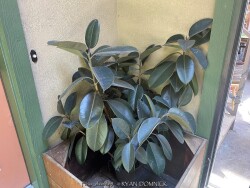

***Description for this plant available with future update!*** Ficus elastica is also known as Indian Rubberplant (Tropical).
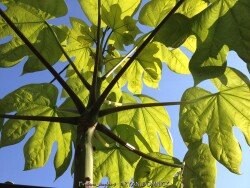

Chinese Parasol Tree (Firmiana simplex) is typically grown as a hardy tropical with huge green leaves and bright green stems that last through winter. This "die to the ground each winter" tree is even more impressive from water strout shoots from the ground. When grown in Kansas, it can be used as summer patio plant tolerating root-boundness well. Water regularly and place in full sun or part shade and enjoy all summer long into late fall. Potted plants are hardy to at least 25 degrees F for a short time if kept dry so you can wait awhile to move these in for the winter. Do not allow the pot with rootball to freeze solid though. Move into a cold garage or basement over the winter. Provide minimal watering and allow the foliage to go dormant and drop off if not already. Bright green stems will remain and add interest during winter. Place back out in April or May with a time-release fertilizer. Landscapers mainly plant Chinese Parasol "Tree" as a die-back to the ground woody perennial "tree". Even without mulch, it is easy to overwinter Firmiana simplex in the ground in Kansas as a woody perennial; complete die-back happens every 1-2 years. The resulting water sprouts from the ground create a bold tropical effect with robust bright green shoots resembling pool cue sticks reaching 5-8' in one season from a 3gal container! We have measured leaves up to 36" long aranded in whorls along the stems. Plants can exceed 15 feet with two consecutive years with no die-back when planted on a South wall. In Eastern Kansas, typically our 40 inches of rainfall is sufficient without extra water in good soils. Chinese Parasol Tree has been planted in our trial gardens and at several residential gardens in Lawrence, KS (zone 6a) 5-10 years ago. During the arctic blast of February, 2021, lows down to -17 degrees F on Feb 16th, 2021 were recorded. The longevity of this cold blast was also impressive: 10 days on a row with highs of 10-15 degrees F or lower, 8 nights of lows in the single digits and negatives, and 36 straight hours of 0 degrees F and mostly lower. Most plants survived with complete die-back and new spring water sprouts. This species is an aggressive, invasive weed in the warmer parts of North America south of zone 7b but not in Kansas because seeds never have a chance to form. Taking 5-7 years to reach flowering size, die-back is much more frequent than that in zone 6. Wow, what a "releaf"!


Chinese Parasol Tree (Firmiana simplex) is typically grown as a hardy tropical with huge green leaves and bright green stems that last through winter. This "die to the ground each winter" tree is even more impressive from water strout shoots from the ground. When grown in Kansas, it can be used as summer patio plant tolerating root-boundness well. Water regularly and place in full sun or part shade and enjoy all summer long into late fall. Potted plants are hardy to at least 25 degrees F for a short time if kept dry so you can wait awhile to move these in for the winter. Do not allow the pot with rootball to freeze solid though. Move into a cold garage or basement over the winter. Provide minimal watering and allow the foliage to go dormant and drop off if not already. Bright green stems will remain and add interest during winter. Place back out in April or May with a time-release fertilizer. Landscapers mainly plant Chinese Parasol "Tree" as a die-back to the ground woody perennial "tree". Even without mulch, it is easy to overwinter Firmiana simplex in the ground in Kansas as a woody perennial; complete die-back happens every 1-2 years. The resulting water sprouts from the ground create a bold tropical effect with robust bright green shoots resembling pool cue sticks reaching 5-8' in one season from a 3gal container! We have measured leaves up to 36" long aranded in whorls along the stems. Plants can exceed 15 feet with two consecutive years with no die-back when planted on a South wall. In Eastern Kansas, typically our 40 inches of rainfall is sufficient without extra water in good soils. Chinese Parasol Tree has been planted in our trial gardens and at several residential gardens in Lawrence, KS (zone 6a) 5-10 years ago. During the arctic blast of February, 2021, lows down to -17 degrees F on Feb 16th, 2021 were recorded. The longevity of this cold blast was also impressive: 10 days on a row with highs of 10-15 degrees F or lower, 8 nights of lows in the single digits and negatives, and 36 straight hours of 0 degrees F and mostly lower. Most plants survived with complete die-back and new spring water sprouts. This species is an aggressive, invasive weed in the warmer parts of North America south of zone 7b but not in Kansas because seeds never have a chance to form. Taking 5-7 years to reach flowering size, die-back is much more frequent than that in zone 6. Wow, what a "releaf"!
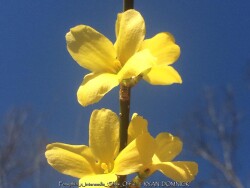

Show Off® Forsythia (Forsythia x Mindor 'Show Off') "shows off" its bright yellow early spring flowers. Improved flower display compared to older varieties. Compact. Deer resistant. Good for cut displays. An excellent specimen plant for mixed borders and foundations. Prefers a good loose soil, but will do well in any soil. pH adaptable and withstands city conditions and is air pollution tolerant. Pruning is best done immediately after flowering. Old stems can be removed or can be cut back to the ground. Shaping should be done at this time. Prefers medium moisture. Fertilize in early spring by applying a slow release fertilizer specialized for trees and shrubs. Follow the label for recommended rate of application. This little beauty will be a blast of early spring color from the ground up! Show Off is not your typical forsythia! It is compact and full of blooms from the ground to the end of every stem. Older varieties can become out of control and often become victims of bad pruning; this little beauty will stay small so there is less need to prune. Now you can have a nice tight, compact forsythia hedge without doing any work! A real improvement over older varieties, Show Off is a very showy choice for the early spring garden. In Eastern Kansas, this cultivar performs WELL with just about everything nature has to challenge it! All Proven Winners® plants are legally propagated, healthy and vigorous, true to name, and tagged with color pictures and growing information.
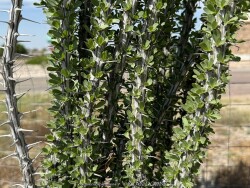

Ocotillo in also known as Fouquieria splendens Not a true cactus but more of a drought deciduous shrub, ocotillo is native to the Mojave desert south to the desert of Baja California, it's usually grown as a patio or house plant in Kansas. In the wild, established species are hardy to 10 degrees F. Grow in full sun with no extra watering except that which comes from rainfall. Repotting may or may not be needed depending on how large you want the plant to grow; plants can continue to grow taller and tolerate extremely root-bound pots but may need wind bracing. If repotting, make sure to use a sharp draining low organic cactus mix with plenty of sand and perlite. Potted plants are hardy to at least 25 degrees F for a short time if kept dry so you are ok if you miss the first light frost. Do not allow the pot with rootball to freeze solid though. Before extreme cold occurs, move to a bright interior window over the winter with no watering and keep above freezing. As a winter house plant, it will look presentable all winter long with just no waterings.(also to prevent lanky winter growth) As a permanent house plant, provide bright light and allow the soil to dry between waterings for many years of carefree enjoyment. Plants grown permanently indoors may begin to elongate stretching for light and lose their color. It can be hard to reproduce the intense UV sunlight they need so moving outside for the summer is best. Generally if moving outside for the summer, allow 1-2 weeks of part shade or morning sun before placing in full sun. Plants with time to acclimate will thrive in full sun but be careful not to rush it or sunburning will occur. Potted plants are very low maintenance.